Centreon Engine: let’s look at this comparison with Pandora FMS
“Centreon Engine”
What is Centreon Engine? Well, Wikipedia was created for this purpose in the social sciences: there you will find the article in Spanish and French (I’m sorry, they haven’t written it yet in English) they talk about their history and characteristics, although it doesn’t say anything about their technical specifications, as this is an encyclopaedia, not a user’s manual or a technical manual.
Here, we are going to present a comparison with Pandora FMS. Although, of course, we always dedicate much more time to Pandora FMS, because this is what the blog is all about. However, our flexibility is at all levels; we have no hesitation in reviewing alternatives, and one of them, which is little known outside its country of origin, is Centreon Engine.
Brief analysis
We must point out (and you won’t find this in Wikipedia) that Centreon has 70% of its clients in France and this same year 2018 expanded its operations to North America, in Canada and right here, in the European Union, in the “Benelux” region (Belgium, Netherlands -Nederland and Luxembourg), where there is a market of 30 million people and five languages are spoken. One of them is French (in Canada as well) and of course English, the two languages of the Centreon Engine.

Although Centreon’s official blog explains in detail how to translate Centreon Engine into each other’s language – and share in the Centreon repository hosted by GitHub, we see only those two published languages. From now on we start to see the differences: Pandora FMS is in Spanish, English, Japanese, Estonian and French.
Now, the reason that this set of applications written in free software and open source are in English is because the Centreon Engine is based on the famous Nagios, “father” of many software, and here many colleagues have written on the subject. Let’s have a look at this.
Nagios is everywhere
We want to give you a summary about Nagios and what we have published in our blog:
- “Zabbix vs Nagios vs PandoraFMS: an in-depth comparison”.
- “Zenoss vs Nagios vs Pandora FMS.”
- “Cacti vs Nagios vs Pandora FMS in depth.”
- “The 16 Best Network Monitoring Tools of 2016.”
We cannot deny reality: the community of Nagios developers, users and plugins is very large worldwide and Centreon Engine has that same fame, although currently there is no trace or reference to the name Nagios in its source code. This is because they have added multiple features that enhance it but currently make it incompatible with Nagios. The icing on the cake is that once there was software called “Isyvmon”… which was based on Nagios and Centreon!
We cannot confirm that Nagios is perfect. We even know, from our own experience with Pandora FMS, that Nagios is not necessarily the solution for all companies. That’s why we always offer you Pandora FMS as a reliable alternative at all times.
The operation of the Centreon Engine
In our opinion, Centreon has four basic components:
- Data collector (called “Poller”): it is equipped with a Centreon Machine with “cbmod”, which delivers data to the Centreon Broker SQL (see point N° 2) and is equivalent to the “Satellite Server” (however, Pandora FMS has a special architecture for isolated environments, as agents can run in proxy mode).
- Central: it is a Data Collector, besides other components, and it is equivalent to the Central Server in Pandora FMS.
- Centreon: communicates with the Apache server (see component N° 4). Receives data for the RDDTool graphics (see last component of this list).
- CentCore: communicates from the Centreon and orders the Data Collectors.
- Centreon Broker SQL: receives from the Data Collectors and stores them, in addition to feeding the next component in this list.
- Centreon Broker RRD: receives from the SQL Broker and stores in files for the Round Robin Database Tool (RRDTool).
- Database: MySQL or MariaDB.
- Apache server as a web server, we’ll just call it Apache. For the Centreon Web Interface we will only need a 1280 x 768 pixel resolution monitor, Chrome web browser, Firefox, Microsoft Internet Explorer® version 11 or higher or Safari®.
Special attention to “cbmod”: it is a module for internal and external communications (IPv4 and IPv6) between the previous components and if it fails it can be configured to save the data in files and when re-establishing the connection they will be properly sent, which Pandora FMS has long established in its specific Tentacle protocol.
Installation and commissioning
First we have to check how many devices we are going to monitor in order to choose the most suitable architecture. X versions running on CentOS 7 or Red Hat OS 6.
Basic architecture
Up to 200 devices we will only need the basic architecture: 1 central server with 2 gigabytes RAM, 2 64 bits cores as minimum that will house a Central, a Database and an Apache server. From 10 thousand devices we will need twice these requirements (see next architecture), except the disk space that would be four times bigger.
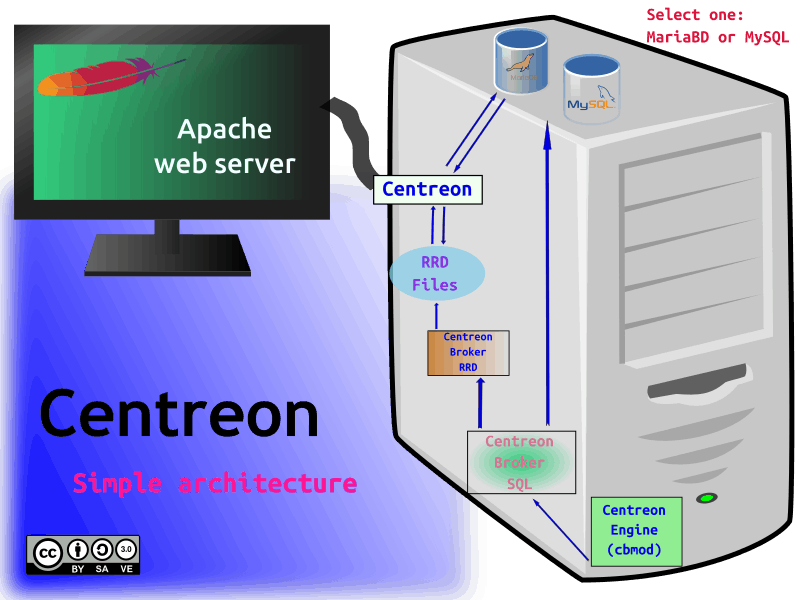
In the case of Pandora FMS, a Central Server will be able to do double of the work: a monitoring without agents (basic) and with agents (Centreon Machinery style). As you can see, flexibility is not just about words, it’s about facts:
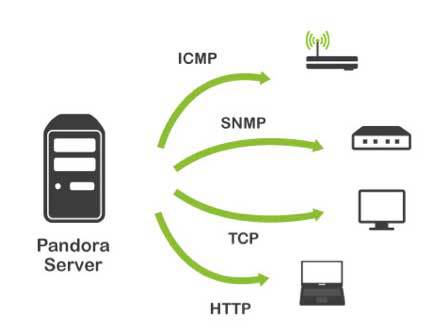
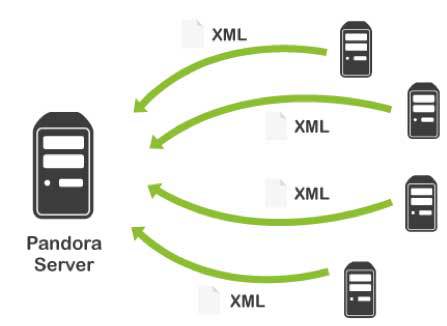
Distributed Architecture
It consists of a Central Server and a Data Collector (“Poller”) at least and as many Data Collectors as we need (depending on the number of devices to monitor). One thing to keep in mind is that each Central is preconfigured to collect data every 5 minutes, retain a history of 6 months and graphics with maximum 2 curves: the latter is what we see as needed, and even would be great to have 100 gigabytes on disk for the database and 10 gigabytes for Centreon, a conservative figure for current equipment.
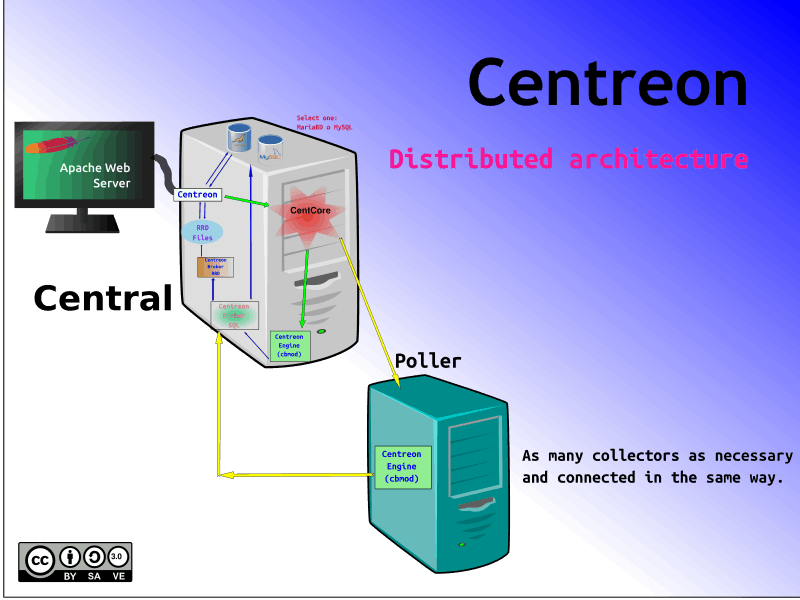
For Pandora FMS, with a Central Server and the agents, and the same hardware required by the Centreon Machinery (Basic Architecture), we can easily monitor 10 thousand devices without any problem. In the case of having a “Satellite Server” (which is similar to a Data Collector in this Distributed Architecture) we will be able to handle up to 150 thousand devices!
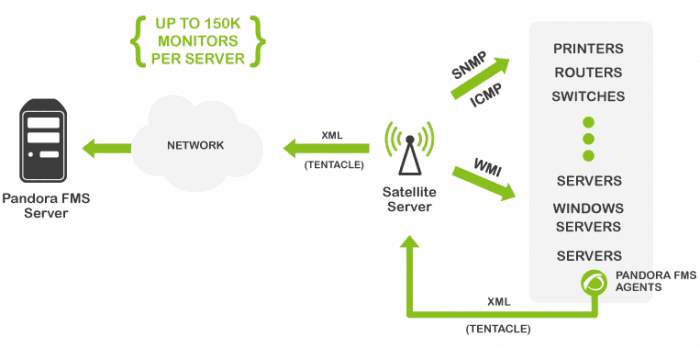
Distributed Architecture with a remote database
It needs the previous scheme and as its name indicates it will have the database in a separate server, communicating with Central and this one in turn with the one or the Collectors of Data that we need.
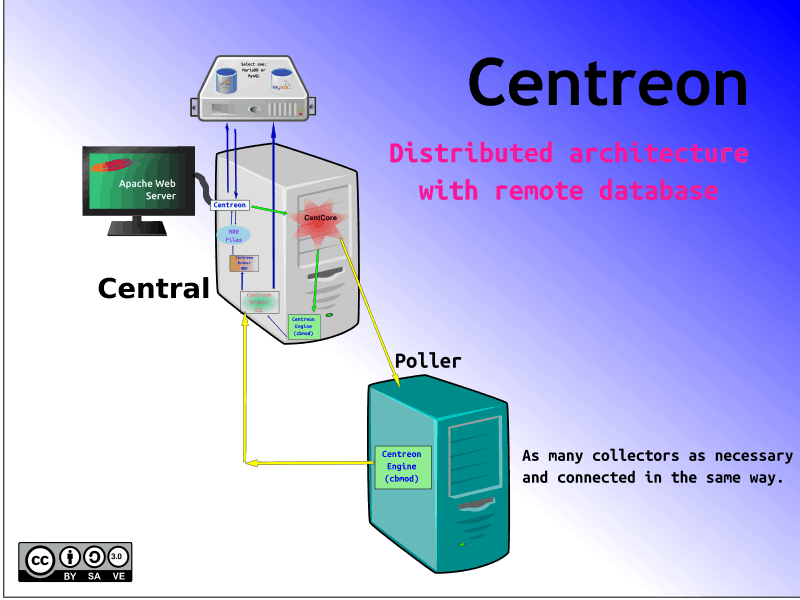
In comparison, Pandora FMS even goes beyond placing a remote database: each component is modular, and we can place each of the servers in separate machines, including of course the database and even the Web Console! We show it to you in a basic monitoring image:
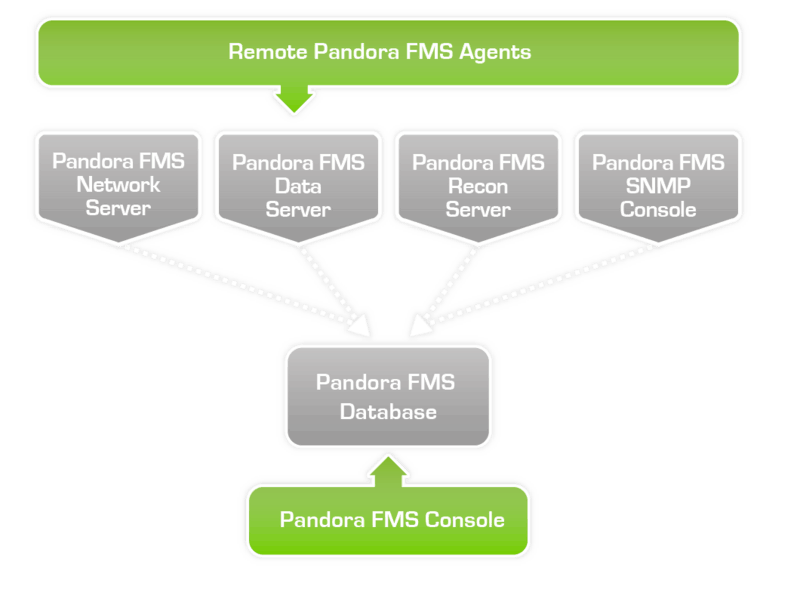
A new feature in the database management is to be able to install them as clusters and it is available from Pandora FMS NG 724 version. You can read its presentation here and its technical features in this link, which we have not yet translated into Spanish, given the novelty of the subject.
Replicated Distributed Architecture
For the Centreon Engine we will have two identical Centrals, one Master who will attend to all the Data Collectors and the other Slave Central with the database replicated and with Centreon Broker RRD and Centreon working. The other components of the Slave Power Station will only be activated in the event of the failure of the Master Station. On the other hand, in Pandora FMS we offer a solution that includes this Architecture and the following one, both together.
Replicated Distributed Architecture with Data Collectors acting as Centrals
Finally, and this is for large organizations, this model of architecture may be a little difficult to understand, but we put it this way: the Data Collectors of the previous scheme become autonomous Centrals, but always send a copy of all their data to the Master Central. In addition, each Central, Master Central, Slave Central or Data Collector, acting as a Central, may have its own Apache server or on a separate machine(s).
Evaluating Pandora FMS, all of the above -and more- is included under one name: “High Availability”. It includes more advanced concepts (Satellite Server, Proxy Agents, Synchronization Servers, etc.) that are not shown in the following graph, for the sake of simplification:
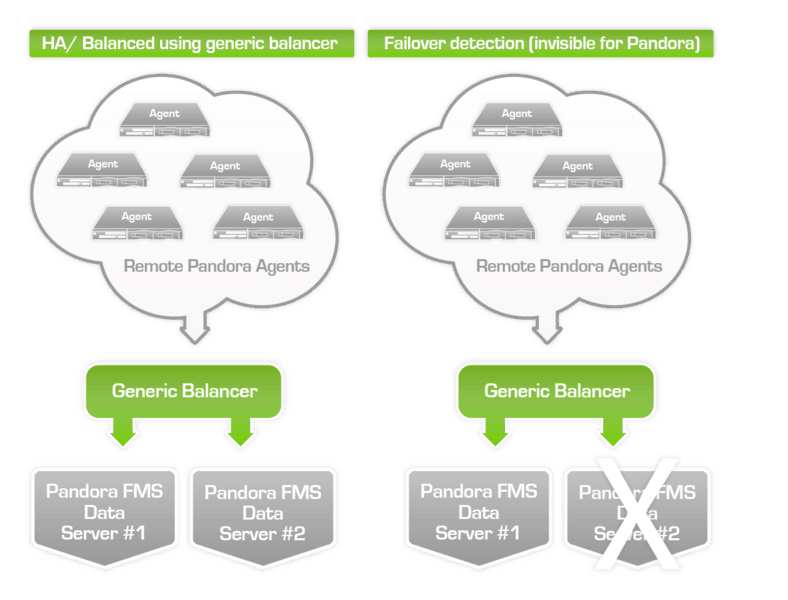
Pandora FMS Architecture
To finish with the topic of architectures -and that we won’t be able to compare with the Centreon Engine, since it doesn’t have an equivalent- is the case of the Export Server, which takes two or more of these Architectures and unifies them in a single database (Pandora FMS has many possible combinations and they are explained in detail in this entry). We can summarize and simplify your concepts in the following two images:

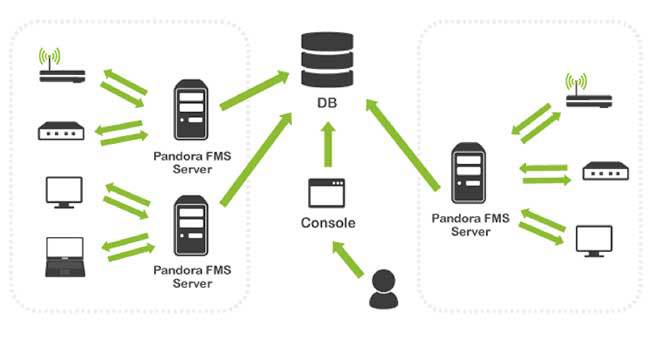
Centreon Web Application Analytics
The first instruction that Centreon gives us is that we must install a Selenium server, a concept that is well known to us, in addition to downloading the corresponding probe from the Centreon repository in GitHub (download the graphical library also “xorg-x11-server-Xvfb” and “xvfb”). This indicates that it has active user experience monitoring and we leave you a link about how this works in Pandora FMS, so that you have all the details about this technology. Here both monitoring solutions go hand in hand.
The graphics system is similar to Cacti’s and has the same drawback: it is based on storing files on disk, i.e. it does not use the database. Pandora FMS takes directly from the database the values in real time.
The Centreon universe
In addition, there are extensive libraries available: the main Centreon core has ten components, some of which we have already mentioned, and others, for example Centreon-PERL-Connector or Centreon-Poller-Display:
- Main Centreon: 10 components.
- Centreon EMS Extensions: 7 components.
- Centreon EPP: 6 components.
- Centreon Community Extensions: 5 components.
With the exception of the last element, the others are included in the Enterprise version, which constitutes the source of incom. We can say that it coincides with Pandora FMS: both come in Community Version and Enterprise Version.
Do you want to go to find out more about monitoring your devices and networks?
Contact us and/or write your comments to this article below!

Programmer since 1993 at KS7000.net.ve (since 2014 free software solutions for commercial pharmacies in Venezuela). He writes regularly for Pandora FMS and offers advice on the forum . He is also an enthusiastic contributor to Wikipedia and Wikidata. He crushes iron in gyms and when he can, he also exercises cycling. Science fiction fan. Programmer since 1993 in KS7000.net.ve (since 2014 free software solutions for commercial pharmacies in Venezuela). He writes regularly for Pandora FMS and offers advice in the forum. Also an enthusiastic contributor to Wikipedia and Wikidata. He crusher of irons in gyms and when he can he exercises in cycling as well. Science fiction fan.
















